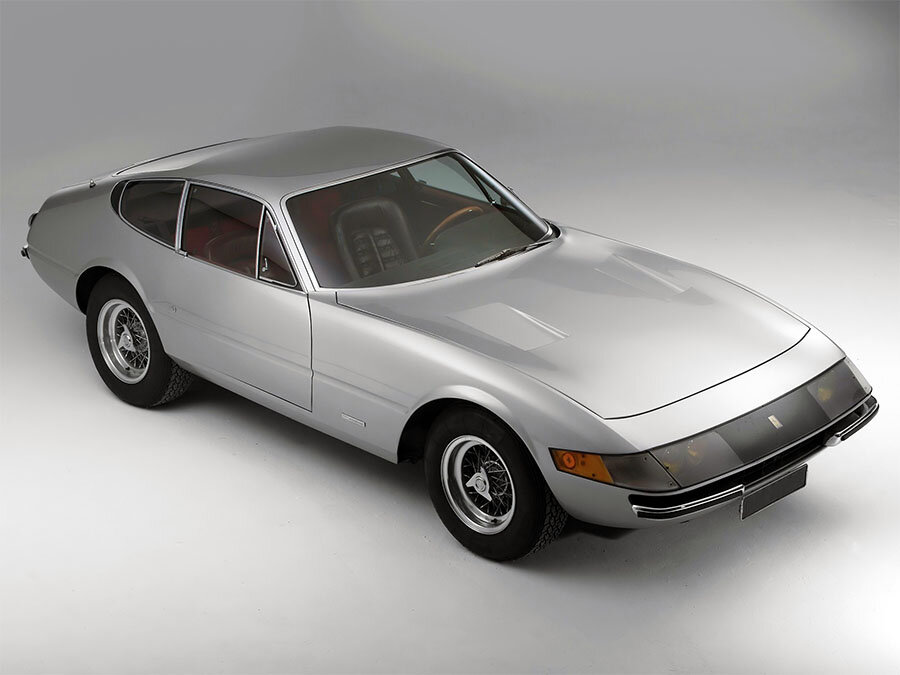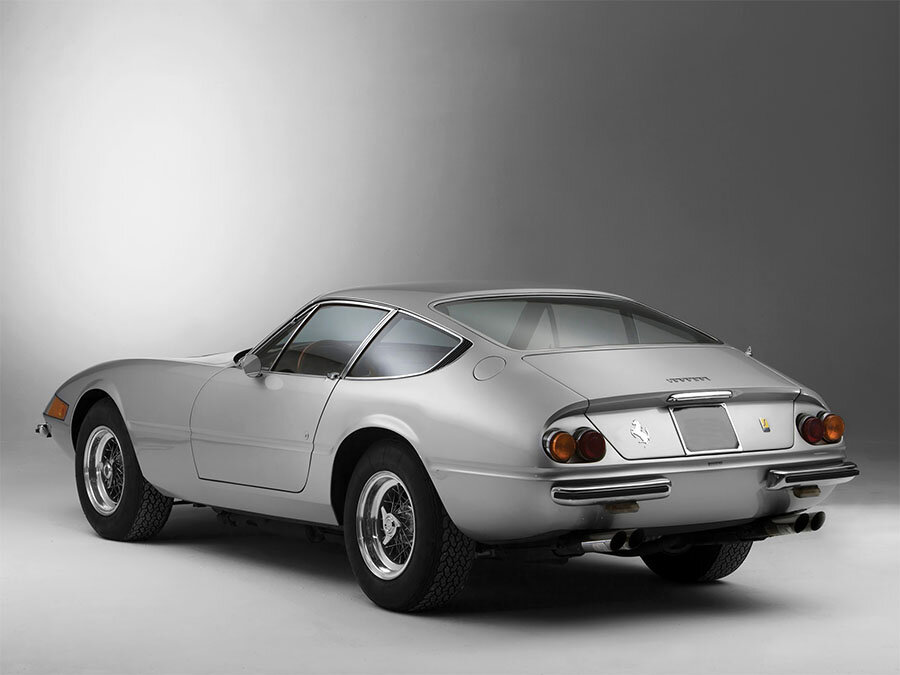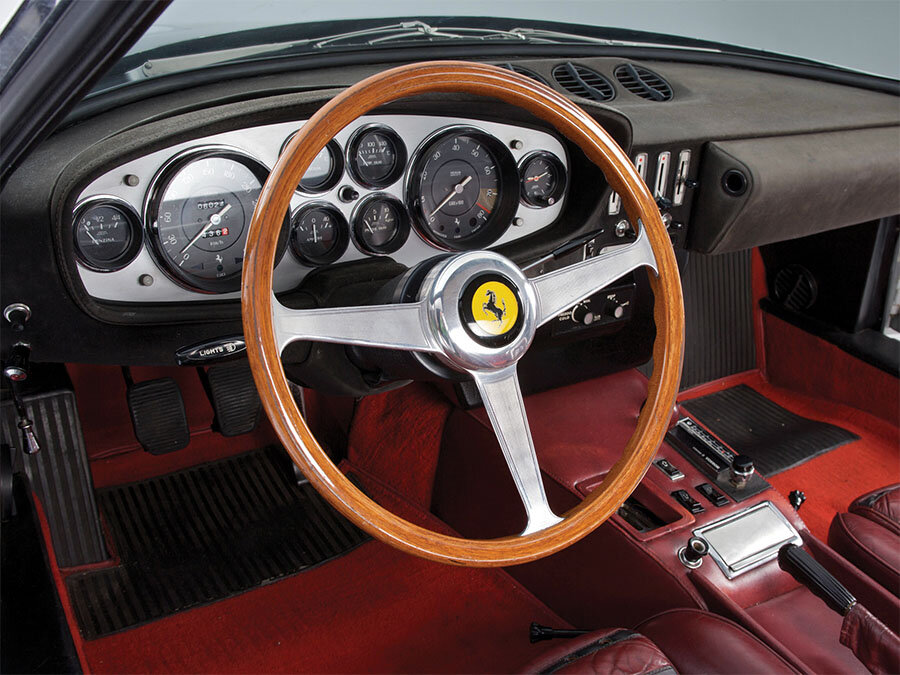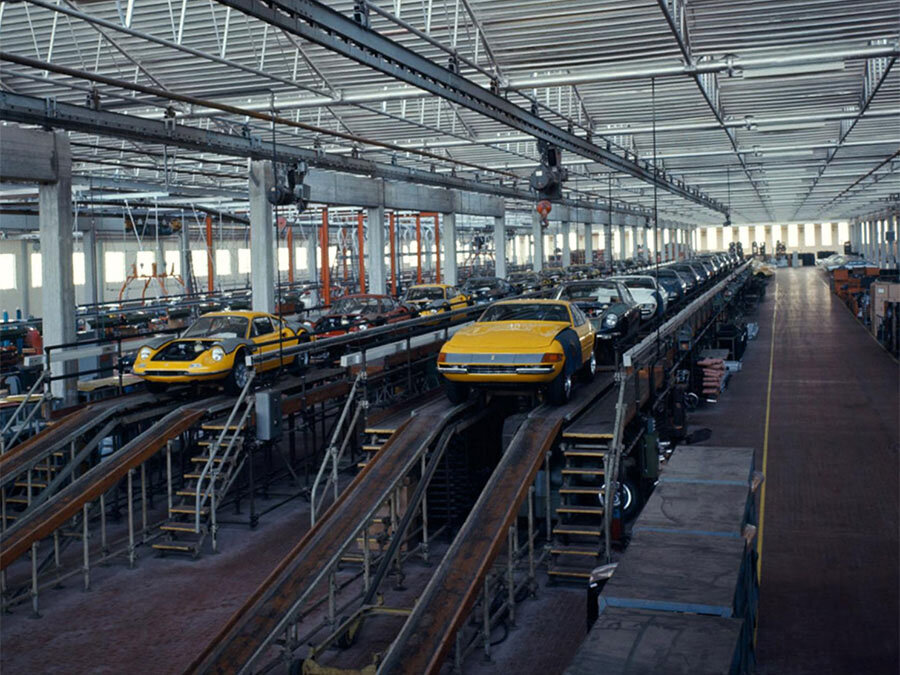Guide: Ferrari 365 GTB/4 & GTS/4 Daytona - a Historical & Technical Appraisal
/BACKGROUND
By the time Ferrari introduced the traditional front-engined 275 GTB/4 in October 1966, there were already two major manufacturers producing exciting large displacement machines with mid-engined layouts.
Ford were the first to offer such a model. Deliveries of Mk1 GT40s in road-going trim had begun in late 1965. Just over twelve months later, the first lucky buyers started to receive their own examples of Lamborghini’s sensational Miura.
Unlike the GT40 (which was constructed in relatively tiny numbers), the Miura represented a big threat to Ferrari given it was a genuine series production model and was also built in Italy.
Ferrari were not oblivious to the mid-engined revolution and their own V6-engined Dino 206 GT had started to roll off the production line in spring of 1968. However, this was an entry level model designed to compete with the Porsche 911.
Although a twelve cylinder mid-engined Ferrari was in the pipeline (the BB), the development programme was running well behind schedule.
To replace the 275 and plug the gap until the BB was ready, a new front-engined two-seat Grand Tourer was created: the 365 GTB/4.
Launched at the Paris Motor Show in October 1968, the 365 GTB/4 was heavier but considerably more powerful than the outgoing 275 GTB/4. Perhaps most importantly though, it had vastly superior braking capability.
The new car was unofficially dubbed Daytona in recognition of Ferrari’s 1-2-3 finish at the 1967 24 Hour race. It slotted into a line up that comprised the recently introduced 365 GTC and 365 GTS (a two-seat Coupe and Spyder respectively), the four-seat 365 GT and the aforementioned Dino 206 GT.
By this time, the firm had discontinued their line of high end flagship models like the 500 Superfast and 365 California.
CHASSIS
The 365 GTB/4 was built around a traditional welded tubular steel chassis. Designated Tipo 605, it retained the 2400mm wheelbase of the outgoing 275, but now featured an inner tub formed of fibreglass.
Suspension was independent all round via unequal length wishbones, coil springs and telescopic dampers.
Anti-roll bars were fitted at either end along with ventilated disc brakes to each corner.
New centre-lock five-spoke Cromodora cast alloy wheels came as standard. These star pattern rims measured 15 x 7.5-inches and were originally shod with Michelin XWX tyres.
Compared to the 275 GTB/4, track was 39mm wider at the front and 36mm wider at the rear.
A 64-litre fuel tank was located in each rear wing for an overall capacity of 128-litres.
ENGINE / TRANSMISSION
In the engine bay was arguably the ultimate incarnation of Gioacchino Colombo's revamped short-block 60° V12. Designated Tipo 251, capacity of this all-alloy motor was dramatically enlarged over its similarly dry-sumped predecessor.
Whereas the 275 displaced just under 3.3-litres, the 365 GTB/4 was taken out to 4.4-litres. This was achieved by increasing the bore by 4mm (to 81mm) and extending the stroke by 12.2mm (to 71mm). Overall capacity was therefore now 4390cc.
Ferrari had already put a couple of 4.4-litre models into production, but whereas the 365 GT and 365 GTC / GTS featured a single overhead camshaft for each bank of cylinders, the 365 GTB/4 used the dual overhead camshaft arrangement pioneered by the 275 GTB/4.
Two valve heads were retained along with single plug ignition and two coils.
With a compression ratio of 9.3:1 and six twin-choke Weber 40 DCN 20/21 downdraught carburettors, these Tipo 251 motors developed 352bhp at 7500rpm. The torque rating was also considerably improved with 318lb-ft on tap at 5500rpm.
Transmission was via a five-speed transaxle with a mechanical single-plate clutch and limited-slip differential.
BODYWORK
The bodyshell was designed by Pininfarina and manufactured at the Scaglietti works in Modena. It featured a chiselled nose, rakish cabin and taught, muscular tail.
Somehow, Pininfarina successfully blended traditional curves with the flat pointy surfaces that would come to define the 1970s wedge era.
Steel was used for everything bar the opening panels which were formed in aluminium.
Apart from a pair of discreet engine cooling vents carved out from the hood, Pininfarina left the 365 GTB/4 remarkably devoid of ducts, blisters and spoilers. The end result was an exceptionally clean design that left no doubt about the car’s high speed credentials.
Perhaps most distinctively, the nose was given a striking Plexiglas panel that featured vertical etchings between the fixed headlights on either side. The only concession to safety was a set of simple chrome quarter bumpers.
INTERIOR
Compared to the new breed of mid-engined supercars, cockpit visibility in the 365 GTB/4 was extremely good.
Leather was used to upholster the bucket seats, transmission tunnel, door panels, cabin pillars, luggage straps and the fluted headliner. Black vinyl was used elsewhere, but although this initially included the dash, fashionable dark grey anti-glare mousehair alcantara soon took over.
The dash itself had been completely redesigned. All eight instruments were now housed in an oval binnacle with a natural alloy fascia directly behind the three-spoke wood-rimmed steering wheel. The large speedometer and rev counter were flanked by a smaller petrol gauge to the left and a clock to the right. Stacked two-by-two in the centre were small read outs for water temperature, oil temperature, oil pressure and battery condition.
Electric windows and a radio were supplied as standard.
OPTIONS
Customers could enhance their cars with a variety of options that were not all available at launch. They included head rests, contrasting leather seat inserts, 9-inch Cromodora rear wheels, air-conditioning, an electric antenna and Borrani wire wheels.
Radios were normally installed by the supplying dealer along with front bumper bars if required.
WEIGHT / PERFORMANCE
Weight was a quoted 1280kg.
Performance-wise, the new car had a top speed of 174mph and 0-62mph time of 5.7 seconds.
365 GTB/4 PROTOTYPES
The 365 GTB/4 displayed at Paris in October 1968 was chassis 11795. This was the third 365 GTB/4 prototype and the first to be equipped with Pininfarina’s production-spec. coachwork. Painted red with a black interior and unique red ribbed seats, 11795 also starred in the original 365 GTB/4 brochure.
Both of the earlier prototypes (chassis 10287 and 11001) used a mixture of experimental features whereas the subsequent trio (11795, 11929 and 12037) only had minor detail differences to the production model.
365 GTS/4 & 365 GTB/4 NOTCHBACK PROTOTYPES
Two new body styles were presented in late 1969.
Unveiled at the Frankfurt Motor Show early in October was a bright yellow 365 GTS/4 (chassis 12851). This car featured a neat folding canvas roof that, when lowered, lay flush with the flattened rear deck. It also came with the heavy black swage line used on several early GTB/4s.
The 365 GTS/4 would eventually enter production, but the first customer cars were not completed until July 1971.
By contrast, the second new body style remained a one-off. Displayed at the Paris Motor Show in late September, chassis 12925 was equipped with a fixed Hardtop-style roof. Painted Blu Tourbillon with a white roof, stainless steel Targa-style roll hoop and zippered plastic rear window, this car also featured new wraparound quarter bumpers and a subtly extended tail section.
EARLY PRODUCTION CHANGES
Production of the standard 365 GTB/4 continued until 1970 without any major changes.
However, because it did not meet basic Federal safety and environmental requirements, the model proved difficult to sell in North America.
Most significantly, the car’s covered headlights were quickly deemed illegal which forced Pininfarina to come up with an alternative solution.
The Turin studio responded by integrating fully retractable headlights to the design. A gradual transition towards pop-up lights for all markets then took place between chassis numbers 13800 and 14200.
For a short time, Pininfarina used a silver-painted band between the indicators to mimic the earlier Plexiglas treatment, but it wasn't long before this panel was switched to body colour.
USA VERSION
Further concessions were also needed to sell the car in the USA.
They included installation of Marelli Dinoplex ignition, twin instead of single Marelli distributors, an anti-smog exhaust system, sealed fuel tanks and some additional dash warning lights.
Compression was dropped from 9.3:1 to 8.8:1 and new Weber 40 DCN 21A carburettors were fitted.
The indicators were switched to all-amber lenses and the tail lights to all red lenses.
Big side marker lights were added to the rear fenders along with small red reflectors between the tail lights and bumpers.
For safety reasons, US-spec. cars were also equipped with octagonal wheel nuts instead of the usual triple-eared spinners.
Chassis 13361 was the prototype US-market 365 GTB/4 and 13893 was the first production example.
365 GTS/4
Soon after the switch to retractable headlights, Ferrari also started to build production versions of the 365 GTS/4.
As a result of the 18-month delay since the prototype had been displayed, the original 1969 Frankfurt Motor Show car (chassis 12851) was the only genuine GTS/4 built with the Plexiglas front end.
A key difference to the Berlinetta was the switch to twin 49-litre fuel tanks which gave the GTS/4 a reduced 98-litre capacity instead of 128-litres.
One GTS/4 (chassis 14547) was supplied with a unique two-tone hardtop. Painted black and silver to give the effect of a brushed steel rollover hoop, it also had a curved rear window.
LATER PRODUCTION CHANGES
Several other developments were made during production.
They included the switch to a smaller diameter leather instead of wood-rimmed steering wheel.
From chassis 15701, the aluminium doors were dropped in favour of steel.
Later US-bound derivatives also came with additional side-impact beams and extra chassis bracing for the bumpers. The combined affect of all these safety measures meant the weight of US variants had risen to 1575kg.
END OF PRODUCTION
Production continued in Berlinetta and Spyder formats until late 1973. At this point, both derivatives were discontinued to make way for the mid-Flat 12-engined 365 GT4 BB.
By the time production ended, Ferrari had completed five prototypes and 1284 production GTB/4s (149 of which were right-hand drive). Around 400 examples were built with the Plexiglas front end.
Two GTB/4s were made with aluminium bodies: chassis 12547 (the Competizione Prototipo that raced at Le Mans in 1969) and chassis 12653 (an otherwise standard road car).
In addition to the solitary 365 GTS/4 prototype displayed at Frankfurt, 121 production Spyders were built (seven of which were right-hand drive).
1971 CANNONBALL RUN
Perhaps the most famous 365 GTB/4 was chassis 14271 which was one of those rare examples completed with the distinctive silver nose band.
A European-spec. machine owned by West-coast car dealer, Kirk F. White, chassis 14271 was entered in the inaugural Cannonball Baker Sea-to-Shining-Sea Memorial Trophy Dash (better known as the Cannonball Run).
It was driven to victory by ex-Formula 1 star, Dan Gurney, and Road & Track journalist, Brock Yates.
Gurney and Yates started the race on November 15th 1971 and completed the 2876-mile journey from Manhattan's Red Ball garage to the Portofino Inn on Redondo Beach in just 35 hours and 54 minutes.
Painted a distinctive blue and yellow colour scheme, chassis 14271 matched the famous Penske Ferrari 512 M that White co-owned (chassis 1040) as well as a competition-spec. 365 GTB/4 he was having built to contest the 1972 Sebring 12 Hours (chassis 14065).
Text copyright: Supercar Nostalgia
Photo copyright: Ferrari - https://www.ferrari.com









































